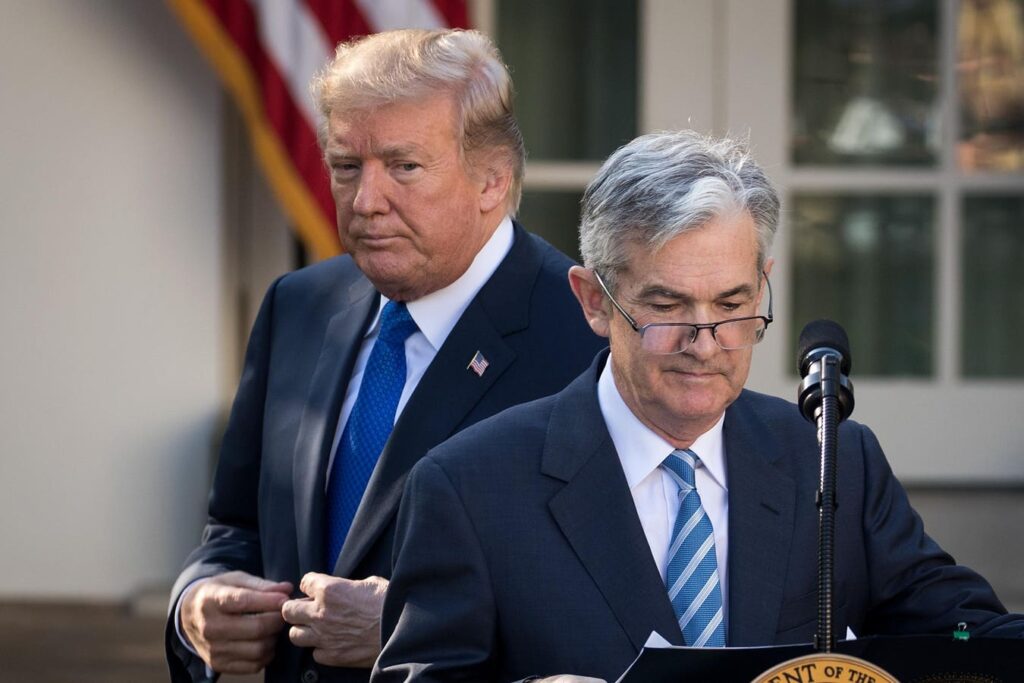WASHINGTON, DC – NOVEMBER 02: (L to R) U.S. President Donald Trump looks on as his nominee for the … More
Getty Images
President Trump continues to aggressively criticize Jerome Powell, the Federal Reserve Chair, whom he nominated to succeed Janet Yellen in 2018. However, despite Trump’s repeated push for lower interest rates, it’s unclear that it is within the scope or ability of the Fed chair to cut the overall interest expense on the national debt.
Increasing U.S. Government Debt
The U.S. government debt has doubled in gross domestic product terms from 60% before the Great Financial Crisis that started in 2007 to 120% today, according to FRED data. U.S. government borrowing now stands at about $36 trillion in absolute terms.
As a result, the cost of simply servicing the national debt is now similar to the entire U.S. Medicare or defense budget. These are very large costs. President Trump’s logic is clear, bringing down interest rates would help save money on debt costs. That, in turn, would help balance the budget.
Markets and Mandates
However, there are two catches:
The overall interest rate on overall government debt depends far more on market forces, not on the very short-term Federal Funds rate that the FOMC sets eight times a year. Those market forces typically matter more for interest rates than the Federal Funds rate.
Achieving low interest rates is not part of the FOMC’s mandate as defined under Section 2A of the Federal Reserve Act. The FOMC is focused on the goals of price stability and full employment together with moderate long-term interest rates. Low interest rates aren’t part of the FOMC’s mandate today. For example, there’s a risk that lower interest rates today could bring inflation, or perhaps aren’t necessary because employment appears to remain robust.
Most U.S. Government Debt Is Longer Term
As of July, U.S. government debt was about 20% bills, that’s debt with a maturity of 4 to 52 weeks. The interest rate on those bills can correlate with the Federal Funds rate set by the Federal Reserve together with expectations for near-term rate decisions.
However, there’s another 80% of government debt that has a longer maturity of up to 30 years. For this, rates are typically set by a host of longer-term forces including inflation expectations, currency trends, economic growth and the fundamentals of supply and demand across asset prices, among other factors. Furthermore, the interest rate the government actually typically pays depends on the interest rate at the time of issuance not the market rate. Much of government borrowing is subject to past debt auctions.
Therefore, the FOMC has limited ability to set the overall rate across all U.S. government borrowing. One example of this is that the Fed Funds rate has remained steady at 4.25% to 4.5% since December 2024, when the FOMC most recently cut rates. During that same period, the rate on the U.S. government 10-year bond has swung from 4.1% to 4.7% on economic news despite no change in policy from the FOMC. That arguably illustrates the extent to which longer-term interest rates are beyond the FOMC’s full control.
Trump Vs. Powell
Trump and Powell are looking for different things. As much as they might want to, Powell and the FOMC cannot control the overall interest rate on U.S. debt. Cutting short-term rates appears unlikely, in isolation, to simply bring down interest costs for longer term-debt, which depends on a range of factors.
Powell often alludes to this with one of his preferred expressions when talking about the neutral rate for interest rates. For example, at a news conference in September 2024, Powell said: “There are model-based approaches and empirically based approaches that estimate what the neutral rate will be at any given time. But, realistically, we know it by its works.”
This hardly suggests that Powell believes he controls the overall term structure of interest rates.
The FOMC controls the very short end of government borrowings and even that is subject to market forces and transmission effects. So, although the president and maybe even Powell might want overall interest rates to be lower, that’s not the FOMC’s mandate — it’s focused on controlling inflation and maintaining job creation.
Of course, President Trump will nominate a new Fed chair for 2026 and it will be interesting to see how that appointee handles the trade-offs between what Trump wants and what the FOMC can achieve under its mandate and with its policy tools.
Additionally, the FOMC may be on track to cut rates later in 2025 anyway so Powell may give Trump a little of what he wants before Powell’s term ends.



